Analysis of Business Organization: Structures, Functions, and Culture
VerifiedAdded on 2023/06/10
|7
|1989
|461
Report
AI Summary
This report provides a comprehensive analysis of business organizations, delving into their structures, operations, and cultural aspects. It begins with an introduction defining a business and its various forms, including sole proprietorships, partnerships, and limited companies, highlighting their respective advantages and disadvantages. The report explores organizational structures, differentiating between hierarchical and flat structures, and their impacts on communication and decision-making. It then examines business operations, such as human resource management, production, marketing, and finance, and how these functions contribute to overall business performance. Furthermore, the report discusses the significance of organizational culture, emphasizing its influence on employee behavior, productivity, and the achievement of business goals. The report concludes by summarizing the key findings and reiterating the importance of a well-defined organizational structure and a positive work environment for success. The report includes references to various academic sources that support the analysis of different aspects of a business organization.
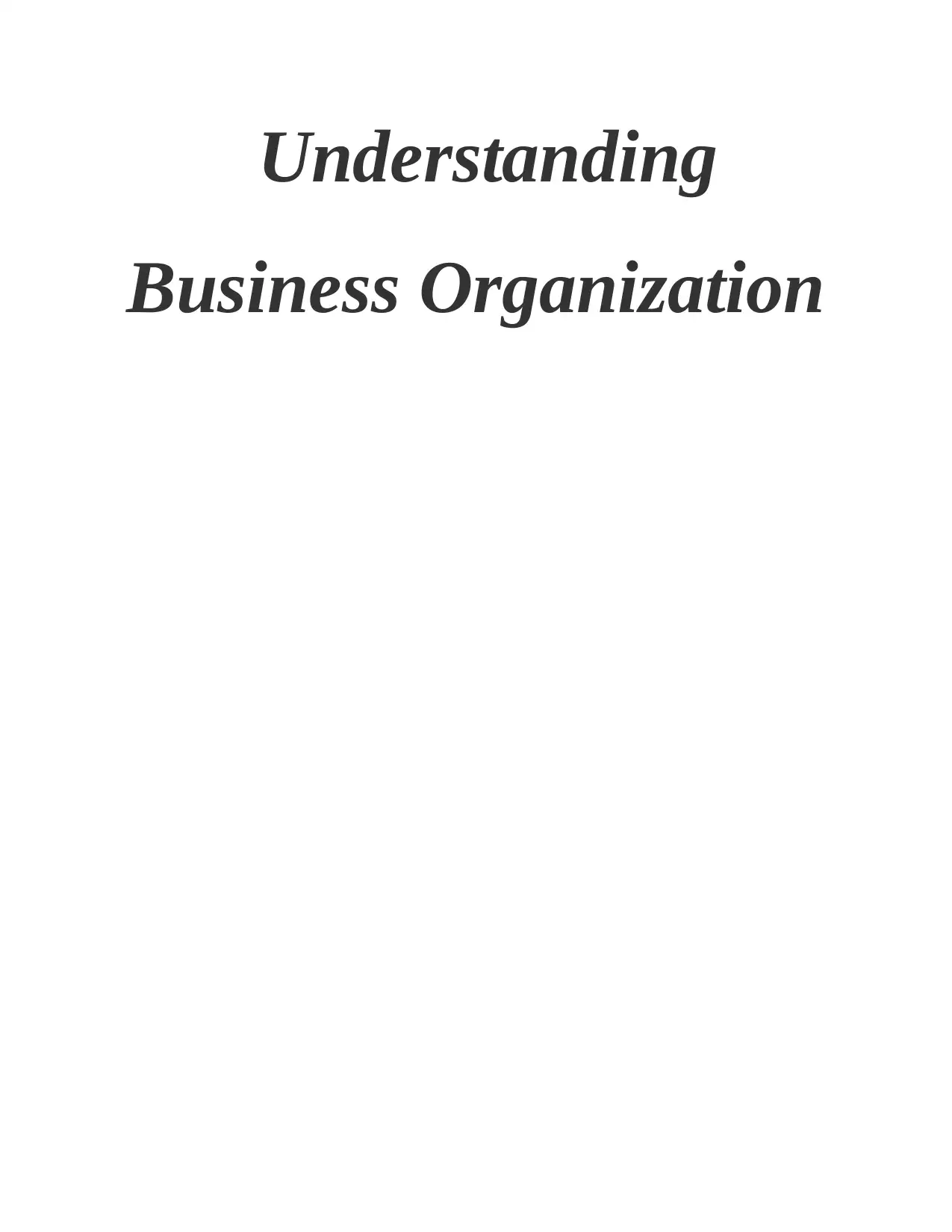
Understanding
Business Organization
Business Organization
Secure Best Marks with AI Grader
Need help grading? Try our AI Grader for instant feedback on your assignments.
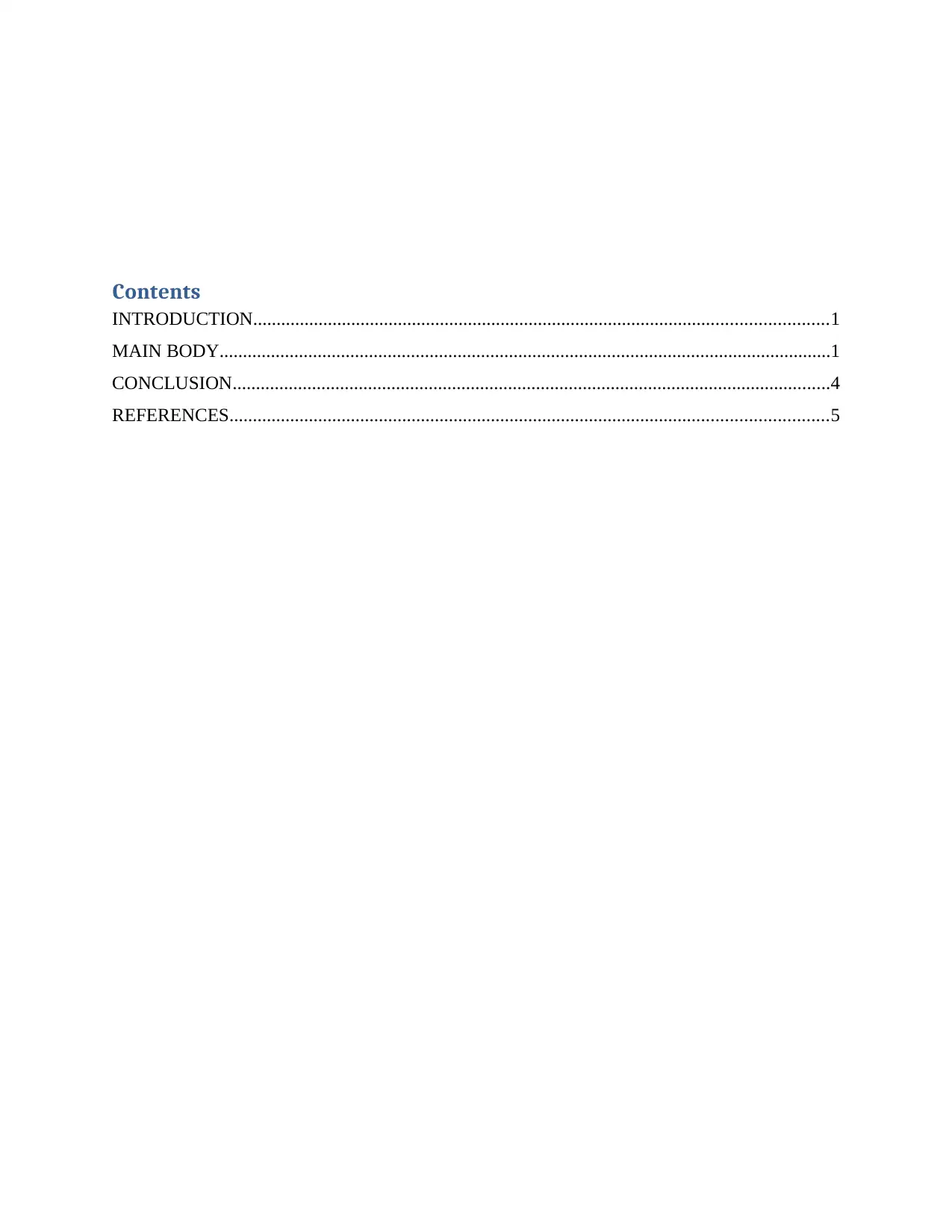
Contents
INTRODUCTION...........................................................................................................................1
MAIN BODY...................................................................................................................................1
CONCLUSION................................................................................................................................4
REFERENCES................................................................................................................................5
INTRODUCTION...........................................................................................................................1
MAIN BODY...................................................................................................................................1
CONCLUSION................................................................................................................................4
REFERENCES................................................................................................................................5
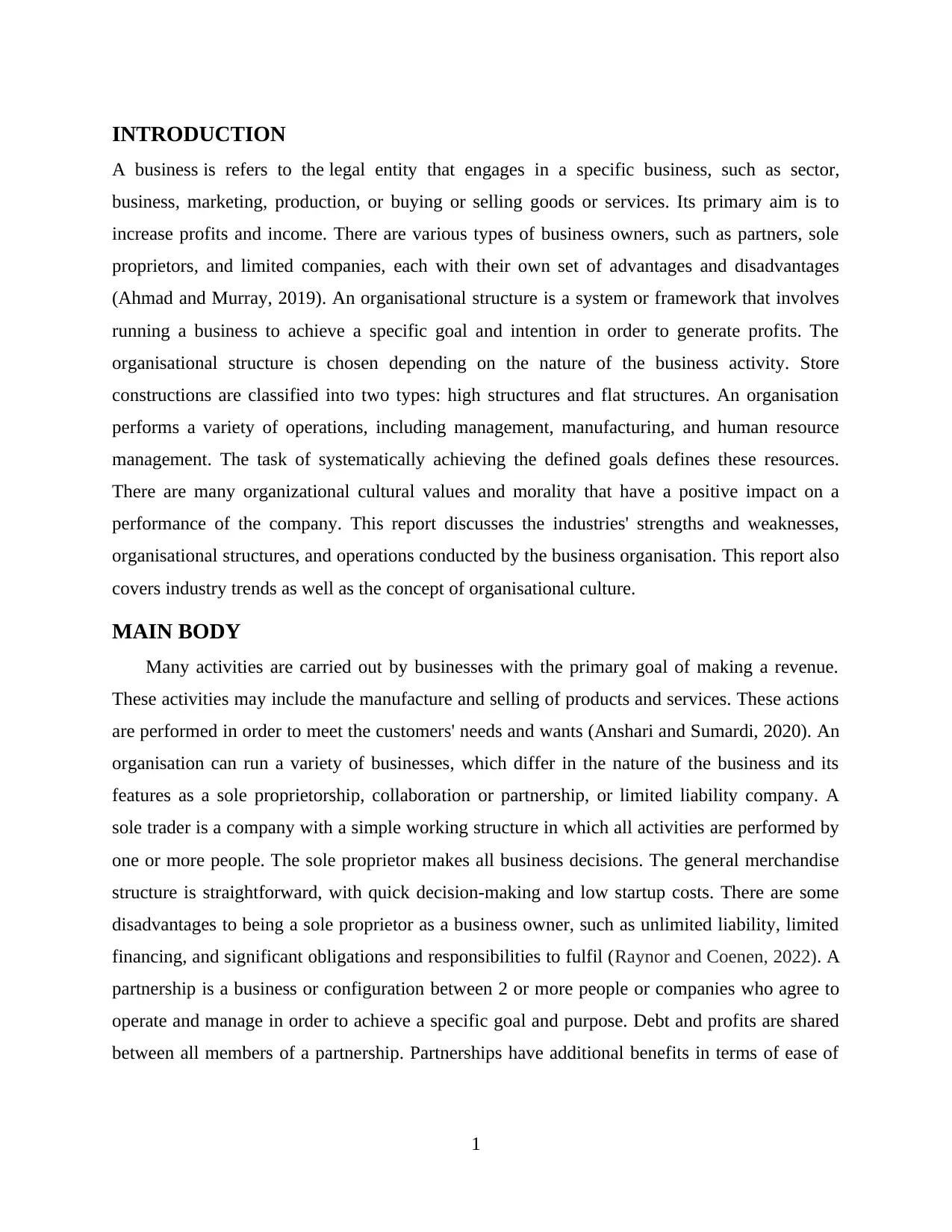
INTRODUCTION
A business is refers to the legal entity that engages in a specific business, such as sector,
business, marketing, production, or buying or selling goods or services. Its primary aim is to
increase profits and income. There are various types of business owners, such as partners, sole
proprietors, and limited companies, each with their own set of advantages and disadvantages
(Ahmad and Murray, 2019). An organisational structure is a system or framework that involves
running a business to achieve a specific goal and intention in order to generate profits. The
organisational structure is chosen depending on the nature of the business activity. Store
constructions are classified into two types: high structures and flat structures. An organisation
performs a variety of operations, including management, manufacturing, and human resource
management. The task of systematically achieving the defined goals defines these resources.
There are many organizational cultural values and morality that have a positive impact on a
performance of the company. This report discusses the industries' strengths and weaknesses,
organisational structures, and operations conducted by the business organisation. This report also
covers industry trends as well as the concept of organisational culture.
MAIN BODY
Many activities are carried out by businesses with the primary goal of making a revenue.
These activities may include the manufacture and selling of products and services. These actions
are performed in order to meet the customers' needs and wants (Anshari and Sumardi, 2020). An
organisation can run a variety of businesses, which differ in the nature of the business and its
features as a sole proprietorship, collaboration or partnership, or limited liability company. A
sole trader is a company with a simple working structure in which all activities are performed by
one or more people. The sole proprietor makes all business decisions. The general merchandise
structure is straightforward, with quick decision-making and low startup costs. There are some
disadvantages to being a sole proprietor as a business owner, such as unlimited liability, limited
financing, and significant obligations and responsibilities to fulfil (Raynor and Coenen, 2022). A
partnership is a business or configuration between 2 or more people or companies who agree to
operate and manage in order to achieve a specific goal and purpose. Debt and profits are shared
between all members of a partnership. Partnerships have additional benefits in terms of ease of
1
A business is refers to the legal entity that engages in a specific business, such as sector,
business, marketing, production, or buying or selling goods or services. Its primary aim is to
increase profits and income. There are various types of business owners, such as partners, sole
proprietors, and limited companies, each with their own set of advantages and disadvantages
(Ahmad and Murray, 2019). An organisational structure is a system or framework that involves
running a business to achieve a specific goal and intention in order to generate profits. The
organisational structure is chosen depending on the nature of the business activity. Store
constructions are classified into two types: high structures and flat structures. An organisation
performs a variety of operations, including management, manufacturing, and human resource
management. The task of systematically achieving the defined goals defines these resources.
There are many organizational cultural values and morality that have a positive impact on a
performance of the company. This report discusses the industries' strengths and weaknesses,
organisational structures, and operations conducted by the business organisation. This report also
covers industry trends as well as the concept of organisational culture.
MAIN BODY
Many activities are carried out by businesses with the primary goal of making a revenue.
These activities may include the manufacture and selling of products and services. These actions
are performed in order to meet the customers' needs and wants (Anshari and Sumardi, 2020). An
organisation can run a variety of businesses, which differ in the nature of the business and its
features as a sole proprietorship, collaboration or partnership, or limited liability company. A
sole trader is a company with a simple working structure in which all activities are performed by
one or more people. The sole proprietor makes all business decisions. The general merchandise
structure is straightforward, with quick decision-making and low startup costs. There are some
disadvantages to being a sole proprietor as a business owner, such as unlimited liability, limited
financing, and significant obligations and responsibilities to fulfil (Raynor and Coenen, 2022). A
partnership is a business or configuration between 2 or more people or companies who agree to
operate and manage in order to achieve a specific goal and purpose. Debt and profits are shared
between all members of a partnership. Partnerships have additional benefits in terms of ease of
1
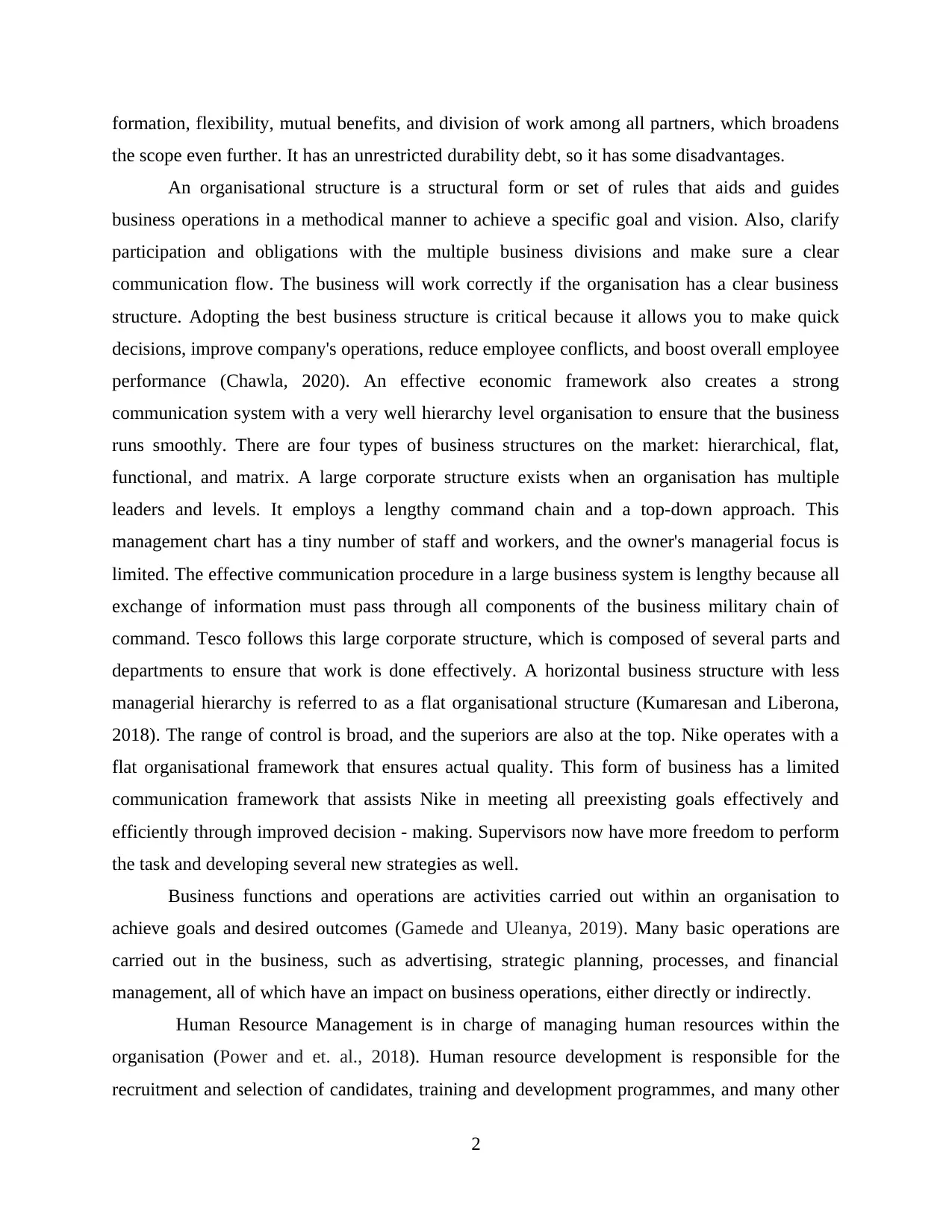
formation, flexibility, mutual benefits, and division of work among all partners, which broadens
the scope even further. It has an unrestricted durability debt, so it has some disadvantages.
An organisational structure is a structural form or set of rules that aids and guides
business operations in a methodical manner to achieve a specific goal and vision. Also, clarify
participation and obligations with the multiple business divisions and make sure a clear
communication flow. The business will work correctly if the organisation has a clear business
structure. Adopting the best business structure is critical because it allows you to make quick
decisions, improve company's operations, reduce employee conflicts, and boost overall employee
performance (Chawla, 2020). An effective economic framework also creates a strong
communication system with a very well hierarchy level organisation to ensure that the business
runs smoothly. There are four types of business structures on the market: hierarchical, flat,
functional, and matrix. A large corporate structure exists when an organisation has multiple
leaders and levels. It employs a lengthy command chain and a top-down approach. This
management chart has a tiny number of staff and workers, and the owner's managerial focus is
limited. The effective communication procedure in a large business system is lengthy because all
exchange of information must pass through all components of the business military chain of
command. Tesco follows this large corporate structure, which is composed of several parts and
departments to ensure that work is done effectively. A horizontal business structure with less
managerial hierarchy is referred to as a flat organisational structure (Kumaresan and Liberona,
2018). The range of control is broad, and the superiors are also at the top. Nike operates with a
flat organisational framework that ensures actual quality. This form of business has a limited
communication framework that assists Nike in meeting all preexisting goals effectively and
efficiently through improved decision - making. Supervisors now have more freedom to perform
the task and developing several new strategies as well.
Business functions and operations are activities carried out within an organisation to
achieve goals and desired outcomes (Gamede and Uleanya, 2019). Many basic operations are
carried out in the business, such as advertising, strategic planning, processes, and financial
management, all of which have an impact on business operations, either directly or indirectly.
Human Resource Management is in charge of managing human resources within the
organisation (Power and et. al., 2018). Human resource development is responsible for the
recruitment and selection of candidates, training and development programmes, and many other
2
the scope even further. It has an unrestricted durability debt, so it has some disadvantages.
An organisational structure is a structural form or set of rules that aids and guides
business operations in a methodical manner to achieve a specific goal and vision. Also, clarify
participation and obligations with the multiple business divisions and make sure a clear
communication flow. The business will work correctly if the organisation has a clear business
structure. Adopting the best business structure is critical because it allows you to make quick
decisions, improve company's operations, reduce employee conflicts, and boost overall employee
performance (Chawla, 2020). An effective economic framework also creates a strong
communication system with a very well hierarchy level organisation to ensure that the business
runs smoothly. There are four types of business structures on the market: hierarchical, flat,
functional, and matrix. A large corporate structure exists when an organisation has multiple
leaders and levels. It employs a lengthy command chain and a top-down approach. This
management chart has a tiny number of staff and workers, and the owner's managerial focus is
limited. The effective communication procedure in a large business system is lengthy because all
exchange of information must pass through all components of the business military chain of
command. Tesco follows this large corporate structure, which is composed of several parts and
departments to ensure that work is done effectively. A horizontal business structure with less
managerial hierarchy is referred to as a flat organisational structure (Kumaresan and Liberona,
2018). The range of control is broad, and the superiors are also at the top. Nike operates with a
flat organisational framework that ensures actual quality. This form of business has a limited
communication framework that assists Nike in meeting all preexisting goals effectively and
efficiently through improved decision - making. Supervisors now have more freedom to perform
the task and developing several new strategies as well.
Business functions and operations are activities carried out within an organisation to
achieve goals and desired outcomes (Gamede and Uleanya, 2019). Many basic operations are
carried out in the business, such as advertising, strategic planning, processes, and financial
management, all of which have an impact on business operations, either directly or indirectly.
Human Resource Management is in charge of managing human resources within the
organisation (Power and et. al., 2018). Human resource development is responsible for the
recruitment and selection of candidates, training and development programmes, and many other
2
Secure Best Marks with AI Grader
Need help grading? Try our AI Grader for instant feedback on your assignments.
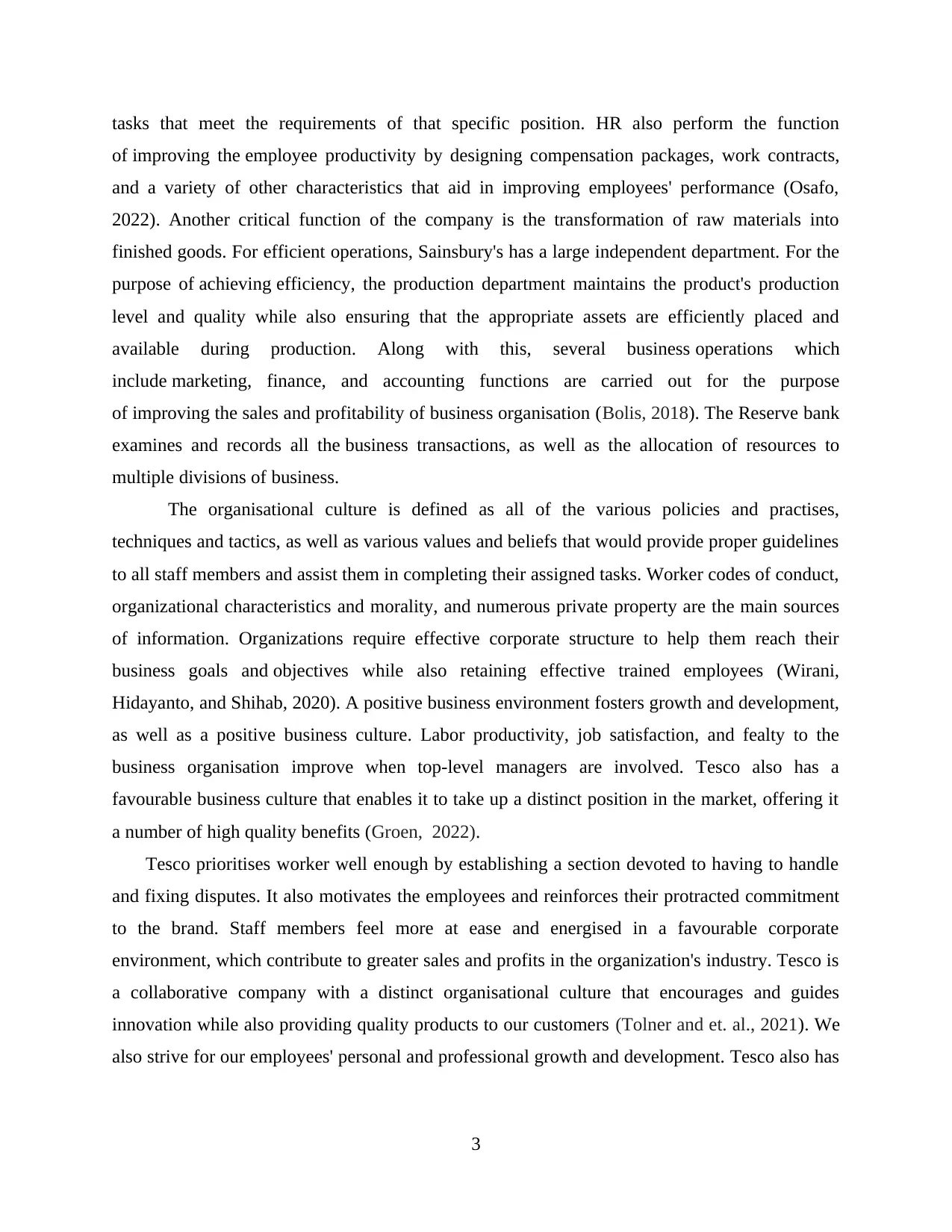
tasks that meet the requirements of that specific position. HR also perform the function
of improving the employee productivity by designing compensation packages, work contracts,
and a variety of other characteristics that aid in improving employees' performance (Osafo,
2022). Another critical function of the company is the transformation of raw materials into
finished goods. For efficient operations, Sainsbury's has a large independent department. For the
purpose of achieving efficiency, the production department maintains the product's production
level and quality while also ensuring that the appropriate assets are efficiently placed and
available during production. Along with this, several business operations which
include marketing, finance, and accounting functions are carried out for the purpose
of improving the sales and profitability of business organisation (Bolis, 2018). The Reserve bank
examines and records all the business transactions, as well as the allocation of resources to
multiple divisions of business.
The organisational culture is defined as all of the various policies and practises,
techniques and tactics, as well as various values and beliefs that would provide proper guidelines
to all staff members and assist them in completing their assigned tasks. Worker codes of conduct,
organizational characteristics and morality, and numerous private property are the main sources
of information. Organizations require effective corporate structure to help them reach their
business goals and objectives while also retaining effective trained employees (Wirani,
Hidayanto, and Shihab, 2020). A positive business environment fosters growth and development,
as well as a positive business culture. Labor productivity, job satisfaction, and fealty to the
business organisation improve when top-level managers are involved. Tesco also has a
favourable business culture that enables it to take up a distinct position in the market, offering it
a number of high quality benefits (Groen, 2022).
Tesco prioritises worker well enough by establishing a section devoted to having to handle
and fixing disputes. It also motivates the employees and reinforces their protracted commitment
to the brand. Staff members feel more at ease and energised in a favourable corporate
environment, which contribute to greater sales and profits in the organization's industry. Tesco is
a collaborative company with a distinct organisational culture that encourages and guides
innovation while also providing quality products to our customers (Tolner and et. al., 2021). We
also strive for our employees' personal and professional growth and development. Tesco also has
3
of improving the employee productivity by designing compensation packages, work contracts,
and a variety of other characteristics that aid in improving employees' performance (Osafo,
2022). Another critical function of the company is the transformation of raw materials into
finished goods. For efficient operations, Sainsbury's has a large independent department. For the
purpose of achieving efficiency, the production department maintains the product's production
level and quality while also ensuring that the appropriate assets are efficiently placed and
available during production. Along with this, several business operations which
include marketing, finance, and accounting functions are carried out for the purpose
of improving the sales and profitability of business organisation (Bolis, 2018). The Reserve bank
examines and records all the business transactions, as well as the allocation of resources to
multiple divisions of business.
The organisational culture is defined as all of the various policies and practises,
techniques and tactics, as well as various values and beliefs that would provide proper guidelines
to all staff members and assist them in completing their assigned tasks. Worker codes of conduct,
organizational characteristics and morality, and numerous private property are the main sources
of information. Organizations require effective corporate structure to help them reach their
business goals and objectives while also retaining effective trained employees (Wirani,
Hidayanto, and Shihab, 2020). A positive business environment fosters growth and development,
as well as a positive business culture. Labor productivity, job satisfaction, and fealty to the
business organisation improve when top-level managers are involved. Tesco also has a
favourable business culture that enables it to take up a distinct position in the market, offering it
a number of high quality benefits (Groen, 2022).
Tesco prioritises worker well enough by establishing a section devoted to having to handle
and fixing disputes. It also motivates the employees and reinforces their protracted commitment
to the brand. Staff members feel more at ease and energised in a favourable corporate
environment, which contribute to greater sales and profits in the organization's industry. Tesco is
a collaborative company with a distinct organisational culture that encourages and guides
innovation while also providing quality products to our customers (Tolner and et. al., 2021). We
also strive for our employees' personal and professional growth and development. Tesco also has
3
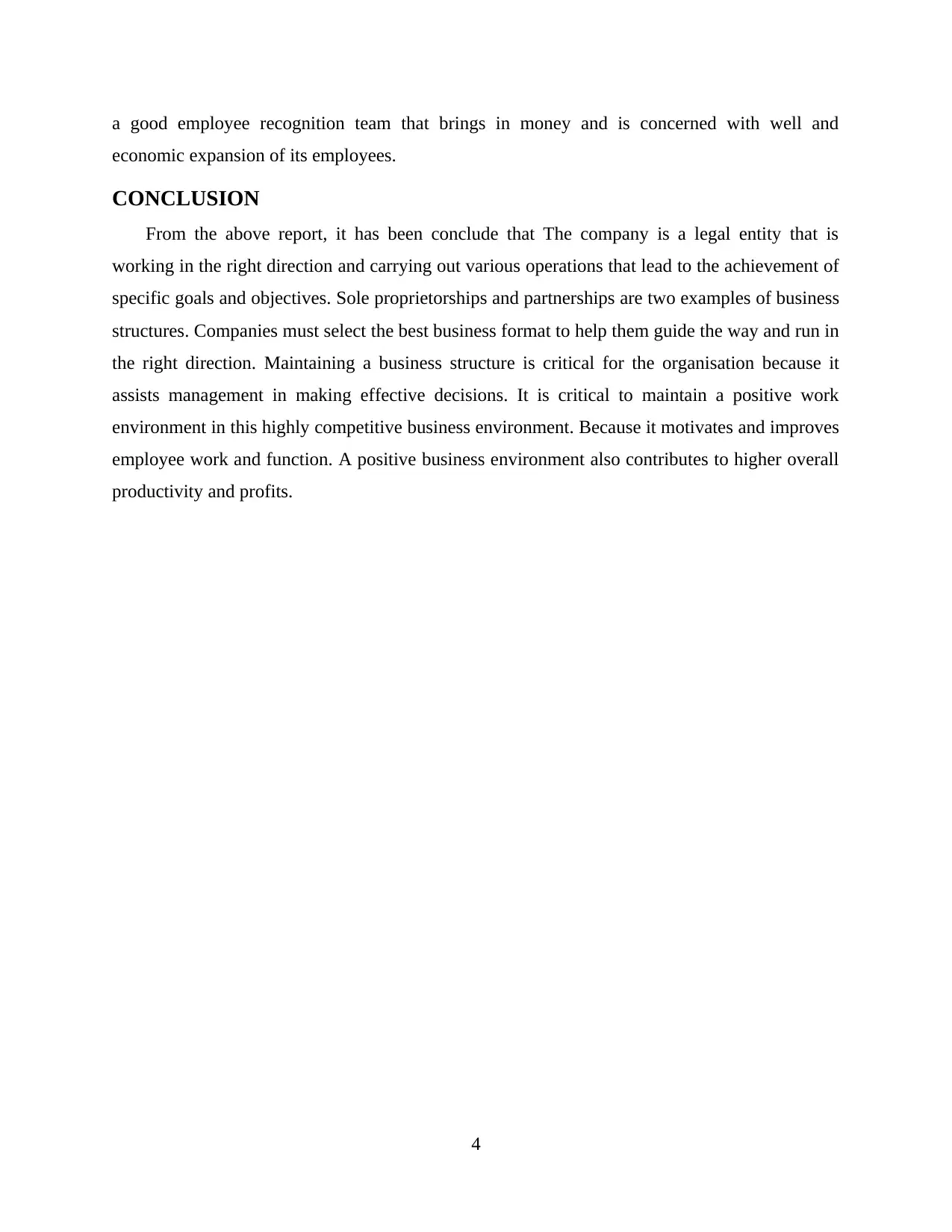
a good employee recognition team that brings in money and is concerned with well and
economic expansion of its employees.
CONCLUSION
From the above report, it has been conclude that The company is a legal entity that is
working in the right direction and carrying out various operations that lead to the achievement of
specific goals and objectives. Sole proprietorships and partnerships are two examples of business
structures. Companies must select the best business format to help them guide the way and run in
the right direction. Maintaining a business structure is critical for the organisation because it
assists management in making effective decisions. It is critical to maintain a positive work
environment in this highly competitive business environment. Because it motivates and improves
employee work and function. A positive business environment also contributes to higher overall
productivity and profits.
4
economic expansion of its employees.
CONCLUSION
From the above report, it has been conclude that The company is a legal entity that is
working in the right direction and carrying out various operations that lead to the achievement of
specific goals and objectives. Sole proprietorships and partnerships are two examples of business
structures. Companies must select the best business format to help them guide the way and run in
the right direction. Maintaining a business structure is critical for the organisation because it
assists management in making effective decisions. It is critical to maintain a positive work
environment in this highly competitive business environment. Because it motivates and improves
employee work and function. A positive business environment also contributes to higher overall
productivity and profits.
4
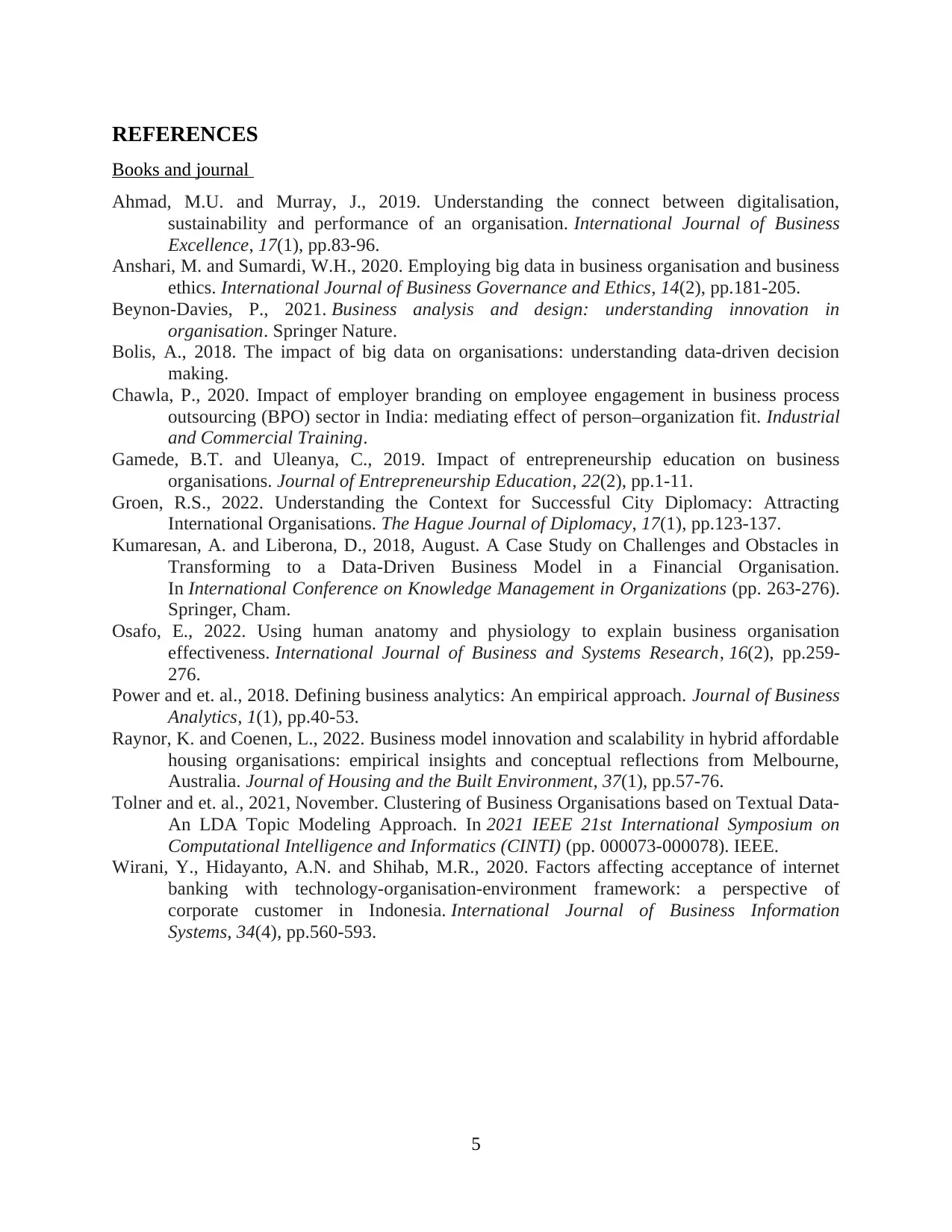
REFERENCES
Books and journal
Ahmad, M.U. and Murray, J., 2019. Understanding the connect between digitalisation,
sustainability and performance of an organisation. International Journal of Business
Excellence, 17(1), pp.83-96.
Anshari, M. and Sumardi, W.H., 2020. Employing big data in business organisation and business
ethics. International Journal of Business Governance and Ethics, 14(2), pp.181-205.
Beynon-Davies, P., 2021. Business analysis and design: understanding innovation in
organisation. Springer Nature.
Bolis, A., 2018. The impact of big data on organisations: understanding data-driven decision
making.
Chawla, P., 2020. Impact of employer branding on employee engagement in business process
outsourcing (BPO) sector in India: mediating effect of person–organization fit. Industrial
and Commercial Training.
Gamede, B.T. and Uleanya, C., 2019. Impact of entrepreneurship education on business
organisations. Journal of Entrepreneurship Education, 22(2), pp.1-11.
Groen, R.S., 2022. Understanding the Context for Successful City Diplomacy: Attracting
International Organisations. The Hague Journal of Diplomacy, 17(1), pp.123-137.
Kumaresan, A. and Liberona, D., 2018, August. A Case Study on Challenges and Obstacles in
Transforming to a Data-Driven Business Model in a Financial Organisation.
In International Conference on Knowledge Management in Organizations (pp. 263-276).
Springer, Cham.
Osafo, E., 2022. Using human anatomy and physiology to explain business organisation
effectiveness. International Journal of Business and Systems Research, 16(2), pp.259-
276.
Power and et. al., 2018. Defining business analytics: An empirical approach. Journal of Business
Analytics, 1(1), pp.40-53.
Raynor, K. and Coenen, L., 2022. Business model innovation and scalability in hybrid affordable
housing organisations: empirical insights and conceptual reflections from Melbourne,
Australia. Journal of Housing and the Built Environment, 37(1), pp.57-76.
Tolner and et. al., 2021, November. Clustering of Business Organisations based on Textual Data-
An LDA Topic Modeling Approach. In 2021 IEEE 21st International Symposium on
Computational Intelligence and Informatics (CINTI) (pp. 000073-000078). IEEE.
Wirani, Y., Hidayanto, A.N. and Shihab, M.R., 2020. Factors affecting acceptance of internet
banking with technology-organisation-environment framework: a perspective of
corporate customer in Indonesia. International Journal of Business Information
Systems, 34(4), pp.560-593.
5
Books and journal
Ahmad, M.U. and Murray, J., 2019. Understanding the connect between digitalisation,
sustainability and performance of an organisation. International Journal of Business
Excellence, 17(1), pp.83-96.
Anshari, M. and Sumardi, W.H., 2020. Employing big data in business organisation and business
ethics. International Journal of Business Governance and Ethics, 14(2), pp.181-205.
Beynon-Davies, P., 2021. Business analysis and design: understanding innovation in
organisation. Springer Nature.
Bolis, A., 2018. The impact of big data on organisations: understanding data-driven decision
making.
Chawla, P., 2020. Impact of employer branding on employee engagement in business process
outsourcing (BPO) sector in India: mediating effect of person–organization fit. Industrial
and Commercial Training.
Gamede, B.T. and Uleanya, C., 2019. Impact of entrepreneurship education on business
organisations. Journal of Entrepreneurship Education, 22(2), pp.1-11.
Groen, R.S., 2022. Understanding the Context for Successful City Diplomacy: Attracting
International Organisations. The Hague Journal of Diplomacy, 17(1), pp.123-137.
Kumaresan, A. and Liberona, D., 2018, August. A Case Study on Challenges and Obstacles in
Transforming to a Data-Driven Business Model in a Financial Organisation.
In International Conference on Knowledge Management in Organizations (pp. 263-276).
Springer, Cham.
Osafo, E., 2022. Using human anatomy and physiology to explain business organisation
effectiveness. International Journal of Business and Systems Research, 16(2), pp.259-
276.
Power and et. al., 2018. Defining business analytics: An empirical approach. Journal of Business
Analytics, 1(1), pp.40-53.
Raynor, K. and Coenen, L., 2022. Business model innovation and scalability in hybrid affordable
housing organisations: empirical insights and conceptual reflections from Melbourne,
Australia. Journal of Housing and the Built Environment, 37(1), pp.57-76.
Tolner and et. al., 2021, November. Clustering of Business Organisations based on Textual Data-
An LDA Topic Modeling Approach. In 2021 IEEE 21st International Symposium on
Computational Intelligence and Informatics (CINTI) (pp. 000073-000078). IEEE.
Wirani, Y., Hidayanto, A.N. and Shihab, M.R., 2020. Factors affecting acceptance of internet
banking with technology-organisation-environment framework: a perspective of
corporate customer in Indonesia. International Journal of Business Information
Systems, 34(4), pp.560-593.
5
1 out of 7
Related Documents
Your All-in-One AI-Powered Toolkit for Academic Success.
+13062052269
info@desklib.com
Available 24*7 on WhatsApp / Email
![[object Object]](/_next/static/media/star-bottom.7253800d.svg)
Unlock your academic potential
© 2024 | Zucol Services PVT LTD | All rights reserved.




